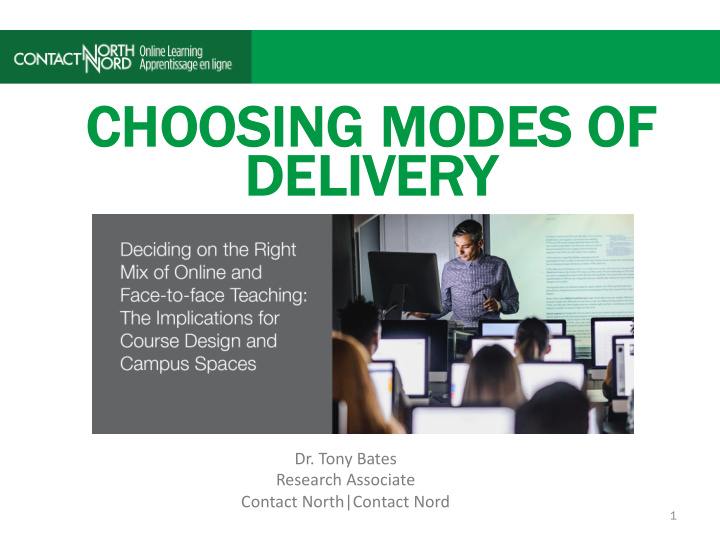



CHOOSING NG M MODES O OF DE DELI LIVERY Dr. Tony Bates Research Associate Contact North|Contact Nord www.contactnord.ca 1
Webinar F Format Aim of series: Discuss issues raised in Teaching • in a Digital Age Draw on your experiences in • addressing these and related issues This webinar: Choosing between modes of • delivery (Chapter 10) 2
Overview: Th This W Webinar • The continuum of technology-based learning • Affordances of campus- based teaching? • Four criteria for choosing mode of delivery • Moving to blended learning • What to do on campus? 3
Multiple M Modes o of D Delivery blended fully online classroom face-to-face hybrid flipped (distance) aids all technology no technology (delivery) 4
Qu Quest stions/Di ns/Disc scussi ssion Which is best? 1. Does this continuum of delivery make sense to you? 2. Is one mode of delivery inherently the best? Why? What does the research say? 3. Comments/other questions on the continuum? 5
Moving t to B Blended/Hybrid L Learning • Last few years: big move to blended/ hybrid learning (in Canada) • Probably all classes will be ‘blended’ by 2025: are they now? • NOT a quantity issue but a QUALITY issue: do it well or do it badly • What is the best use of face-to- face time? What is the right mix? 6
Many F Forms o of B Blended L Learning 1. Technology-enhanced learning (ppt, clickers, active classrooms) 2. f2F (lectures) + LMS (for supporting f2f) 3. Flipped: streamed video + f2f 4. 1 semester on-campus; 2 online (RRU) 5. Hybrid: f2f (reduced) + online How to decide? No theory 7
What A Are t the U Unique A Affordances o of Fa Face-to to-Face T Teaching? • Default position: face-to-face is inherently superior: research says it ain’t so: it’s the conditions that matter • Law of equal substitution: everything can be taught as well online as face-to-face, Why get on the bus to come to except..... campus? • So why get on the bus? What are exceptions? 8
Four C Criteria f for C Choosing 1. Students: which mode(s)? Multiple modes? 2. Identify teaching approach + necessary learner activities 3. What resources are available? 4. Analyse most appropriate mode for each learner activity 9
1. S Students a and M Mode o of D Delivery • Less experienced/younger: ca campus (first year?) • Older/working: on online (graduate; 4 th yr U/G?) • Full-time students working part- time: bl blended • Dependent vs independent: a teachable skill: design it • One course: all modes? 10
2. T Teaching A Approach + + 3 3. L Learner A Activities • Overall course design decision: what kind of course? • What learning outcomes? Content vs skills • What student learning activities? • What resources are available? • Which mode best fits learning activities? 11
Qu Quest stions/Di ns/Disc scussi ssion 1. Does it make sense to choose modes of delivery on this basis? 2. Is this a realistic approach? How else would you do it? 3. Any other suggestions/questions? 12
Moving t to B Blended L Learning • LMS or lecture capture/podcasts or social media/mobile learning? • Start slowly: flipped classrooms? • Move to redesign (hybrid) • Program strategy: increase independent learning gradually • Institutional plan: resources, organisation 13
What t to D Do o on C Campus? • Unique teaching/learning functions? • Impact on campus design • Do we need campuses? If so for what? • Any other questions/comments about role of campus? 14
Moving t to B Blended/Hybrid L Learning Challenges: • Leadership: vision and strategy for teaching/learning often lacking • Organization: support in DE but needed on campus: major re-structuring • Resources: scaling is a problem (from 15% to 100%) 15
Qu Quest stions/Di ns/Disc scussi ssion 1. What are the benefits/drawbacks of moving to blended learning? 2. How is your institution moving to blended learning? Is there a strategy? Do you need one? 3. Any other comments or questions on the move? 16
General D Discussion A About M Modes o of Del Deliver ery? Your q questions/comments 17
Recommend
More recommend